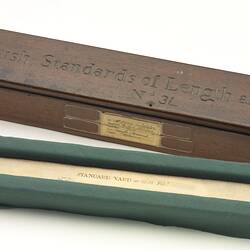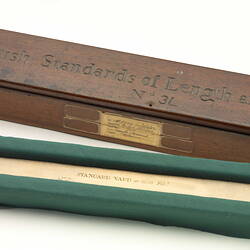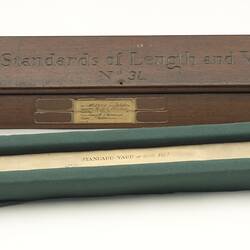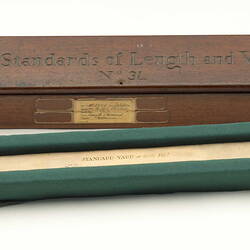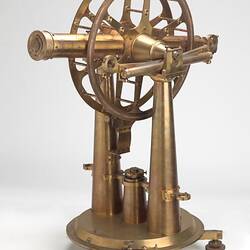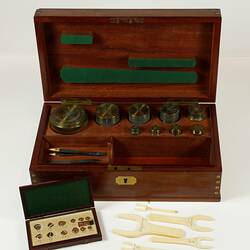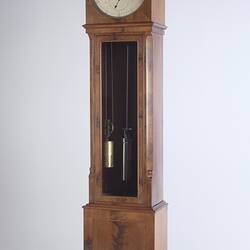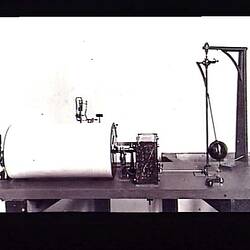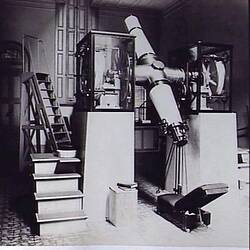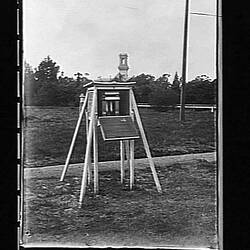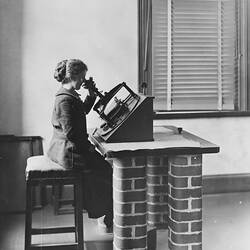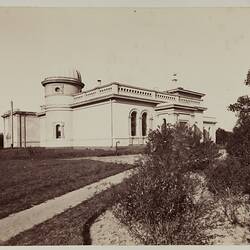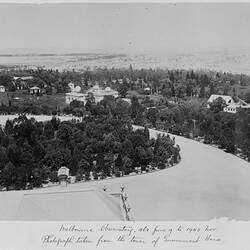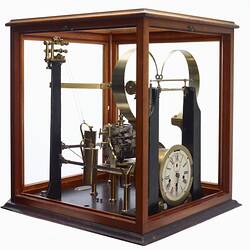Summary
Standard yard made by Troughton & Simms, London, 1855. Parliamentary copy No. 34 of the British standard yard of 1854. Bronze bar in wooden case. The yard is measured between fine lines marked on a gold pin in the well at each end of the bar.
Primary standard yard for Victoria, 1856 to 1966. This standard yard was placed in the custody of Robert Ellery, Government Astronomer, in 1860.
1 yard is approximately 91cm.
Significance
From its inception the Melbourne Observatory had sets of standard weights and measures, which had been tested in Britain against the Imperial standards. These included the primary standard yard and pound for the Colony of Victoria. Other standards of weight and measure in the colony could be compared to these primary standards.
The British Imperial Standards were introduced in 1824, to systematise the varying standards that had been used previously. Unfortunately these standards were destroyed when the British Houses of Parliament burned down in 1834, and new standards had to be established.
Research was undertaken over a ten-year period to choose the best metal for the standard yard, testing the bars carefully at different temperatures to establish its expansion rate. In ten years over 200,000 measurements were made deep in a cellar of the Royal Astronomical Society's building in London, using microscopes to observe the slightest changes in length.
The best bar was nominated the Imperial Standard Yard, and the next best bars were approved as Parliamentary Copies and sent to major cities in the United Kingdom and British colonies. The Victorian standard is Parliamentary Copy No 34 of the British Standard Yard of 1854. It is made from a metal developed by British Astronomer Francis Baily, made up of 16 parts copper, 2½ parts tin and 1 part zinc.
This standard yard was kept with other standard measures in the basement at Melbourne Observatory, to reduce the effects of changes in temperature. Even so special calculations had to be made to allow for the expansion and contraction of the metal in the standard yard. The standard yard was set up in a machine fitted with microscopes, so that exact comparisons could be made of two measures.
More Information
-
Collection Names
Melbourne Observatory Collection, Weights and Measures Collection
-
Collecting Areas
-
Acquisition Information
Transfer from Office of Trade Measurement (formerly Weights & Measures Branch), Victoria: Local Government Department, 28 Sep 1994
-
Maker
Troughton & Simms, London, Middlesex, England, Great Britain, 1855
-
User
Melbourne Observatory, South Yarra, Greater Melbourne, Victoria, Australia, 1861-1944
-
User
Victoria: Weights & Measures Branch, South Yarra, Greater Melbourne, Victoria, Australia, 1944-1966
-
Inscriptions
Metal bar marked "COPPER 16 OZ, TIN 2 1/2, ZINC 1. MR BAILY'S METAL NO. 40. STANDARD YARD AT 61.99 FAHT. EXPERIMENTAL BAR A. TROUGHTON & SIMMS, LONDON" Wooden case carved "BRITISH STANDARDS OF LENGTH & WEIGHT, NO. 34".
-
Classification
-
Category
-
Discipline
-
Type of item
-
Overall Dimensions
113 cm (Length), 8 cm (Width), 10 cm (Height)
-
Exhibition Collection Management
26 mm (Length), 965 mm (Width), 26 mm (Height), 6 (Weight)
Case: L120MM; W1123MM; D90MM;weight is without case
-
Dimensions
26 mm (Length), 1123 mm (Width), 81 mm (Height)
Measurement From Conservation. Measuring Method: Measurements are of box
-
Keywords

